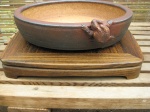Waterfall Scroll #2
5 posters
Page 1 of 1
 Waterfall Scroll #2
Waterfall Scroll #2

This was another variation on the waterfall. It was completed by Mariusz Szmerdt, polish artist. He can be reached at http://sumi-e.home.pl/contact/ This waterfall has more detail than the previous one, but it still focuses on the detail in the water rolling off the rocks, but I purposefully asked the artist to not add other vegetation to compete with a bonsai or Sanyasou in a display. This has a little higher quality cloth silk with a beautiful flower arabesque. When looking from far away it melds together like flowing water. It is completed with the Shibucha stained wood jikusaki and a Kodai San Iro kakehimo.
Dimensions as Follows:
Name in Kanji Name in English Size in Bun Size in Inches
天 Ten 117 13.96
上一文字 Ue Ichimonji 14 1.67
紙本の幅さ Artwork Width 74 8.83
紙本の長さ Artwork Length 127 15.15
柱 Pillars 17 2.03
下一文字 Shita Ichimonji 10 1.19
地 Chi 75 8.95
掛け軸の幅さ Scroll Width 108 12.88
掛け軸の長さ Scroll Length 343 40.92

Kakejiku- Member
 Re: Waterfall Scroll #2
Re: Waterfall Scroll #2
hi,
Does a waterfall with no vegetation have a correct season to display? or does it become an 'all year round' scroll?
thanks Marcus
Does a waterfall with no vegetation have a correct season to display? or does it become an 'all year round' scroll?
thanks Marcus

marcus watts- Member
 Re: Waterfall Scroll #2
Re: Waterfall Scroll #2
I guess the counter question would be if the scrolls primary role in a display is to be the backdrop to a setting or define the season...or sometimes does one role or the other. This painting was done to be very neutral and provide a setting of an actual locale. But if you displayed with Ume 梅 just beginning to flower then the season would be Haru 春. Full Bloom Shonatsu初夏, pine probably Natsu夏 depending on the other accents used, and a deciduous changing color Aki秋. Winter would be difficult in temperate zones (water is not frozen...)
So am not quite sure if I answered your question....
So am not quite sure if I answered your question....

Kakejiku- Member
 Re: Waterfall Scroll #2
Re: Waterfall Scroll #2
was nice to see a question asked after lots of views. having Jonathan as a resource, is a good thing and I think from following his contributions grossly underused.
I'm scrambling to grasp different japanese words in display ( I've got most japanese verbal concepts of Koi and bonsai down pretty good )
but any help of using the japanese word and then as close to an english translation is always appreciated.
I'm quessing haru is mid winter because of ume. Shonatsu, must be late winter? and Natsu must be more spring/summer? I know Aki is fall from being activly involved in aki matusri ( fall festival)....
I'm scrambling to grasp different japanese words in display ( I've got most japanese verbal concepts of Koi and bonsai down pretty good )
but any help of using the japanese word and then as close to an english translation is always appreciated.
I'm quessing haru is mid winter because of ume. Shonatsu, must be late winter? and Natsu must be more spring/summer? I know Aki is fall from being activly involved in aki matusri ( fall festival)....

dick benbow- Member
 Re: Waterfall Scroll #2
Re: Waterfall Scroll #2
dick benbow wrote:was nice to see a question asked after lots of views. having Jonathan as a resource, is a good thing and I think from following his contributions grossly underused.
I'm scrambling to grasp different japanese words in display ( I've got most japanese verbal concepts of Koi and bonsai down pretty good )
but any help of using the japanese word and then as close to an english translation is always appreciated.
I'm quessing haru is mid winter because of ume. Shonatsu, must be late winter? and Natsu must be more spring/summer? I know Aki is fall from being activly involved in aki matusri ( fall festival)....
Every poem utilizing an ume I have read in Japanese refers to Spring. 春=Spring
初夏=Shonatsu which is early summer
夏=Summer
冬=Winter

Kakejiku- Member
 Re: Waterfall Scroll #2
Re: Waterfall Scroll #2
In Haiku category, an ume means spring as mentioned above. But if it combined with another, it could be variable.Kakejiku wrote:
Every poem utilizing an ume I have read in Japanese refers to Spring. 春=Spring
初夏=Shonatsu which is early summer
夏=Summer
冬=Winter
for example, As Summer, ao-ume青梅= blue pram. Winter, kan-bai寒梅=cold pram, sou-bai早梅=early pram and rou-bai蝋梅=wintersweet(chimonanthus praecox)
初夏 isn't Shonatsu, 初夏= Shoka. Same meaning but different pronunciation.
nekotoban- Member
 Re: Waterfall Scroll #2
Re: Waterfall Scroll #2
nekotoban wrote:In Haiku category, an ume means spring as mentioned above. But if it combined with another, it could be variable.Kakejiku wrote:
Every poem utilizing an ume I have read in Japanese refers to Spring. 春=Spring
初夏=Shonatsu which is early summer
夏=Summer
冬=Winter
for example, As Summer, ao-ume青梅= blue pram. Winter, kan-bai寒梅=cold pram, sou-bai早梅=early pram and rou-bai蝋梅=wintersweet(chimonanthus praecox)
初夏 isn't Shonatsu, 初夏= Shoka. Same meaning but different pronunciation.
Thank you for the clarification. You are correct on the reading, I got mixed up on the On and Kun Yomi....In this case I was referring to most poems in general and a specific poem example could be....一花開いて天下の春 page 78 of the 禅語吉語字典 Zengo Kichigo Jiten.

Kakejiku- Member
 Similar topics
Similar topics» Blackthorn
» Waterfall Scroll
» The Waterfall Scroll that was sold
» waterfall! waterfall!
» Literati hawthorn summer installation
» Waterfall Scroll
» The Waterfall Scroll that was sold
» waterfall! waterfall!
» Literati hawthorn summer installation
Page 1 of 1
Permissions in this forum:
You cannot reply to topics in this forum






